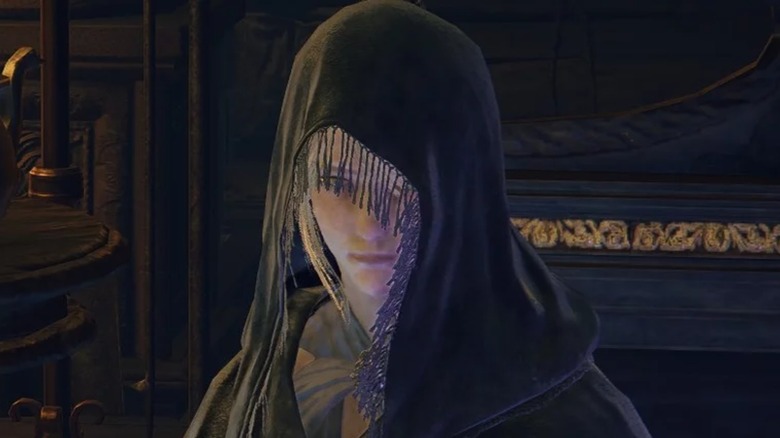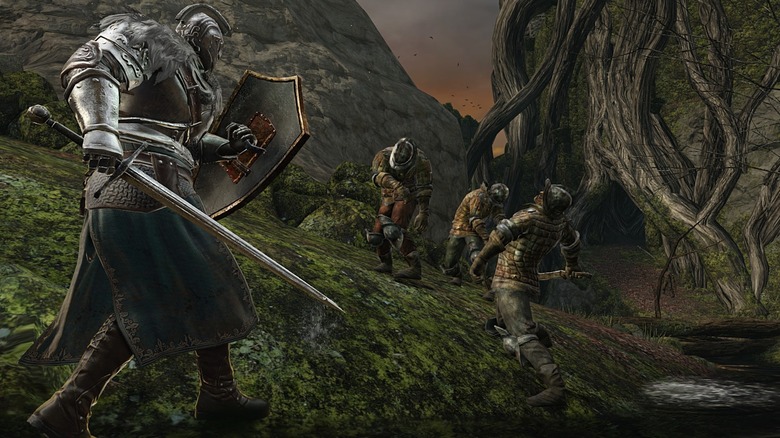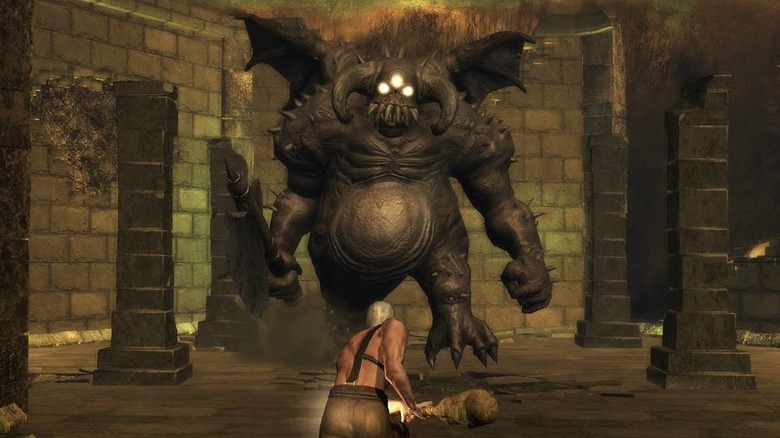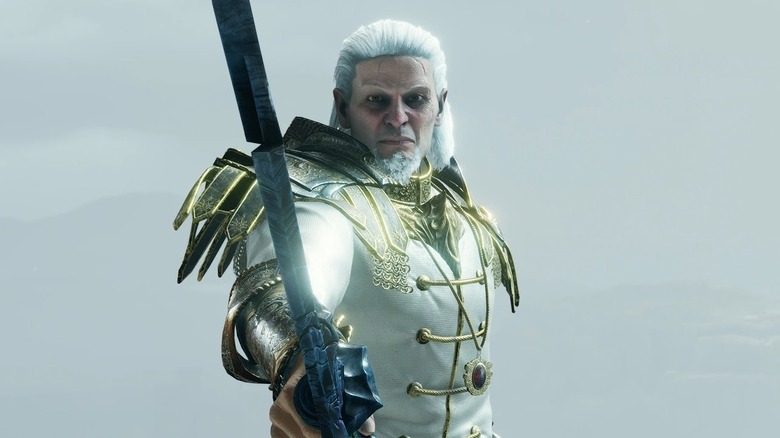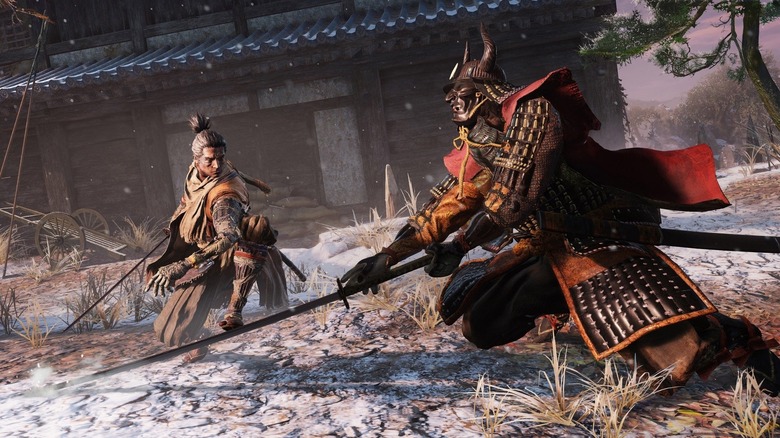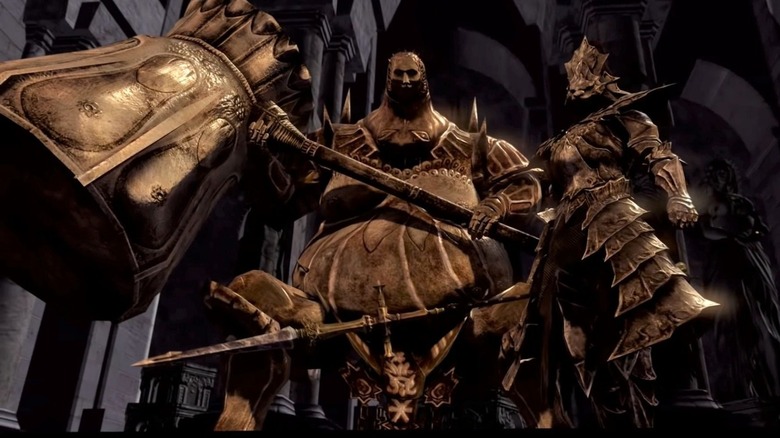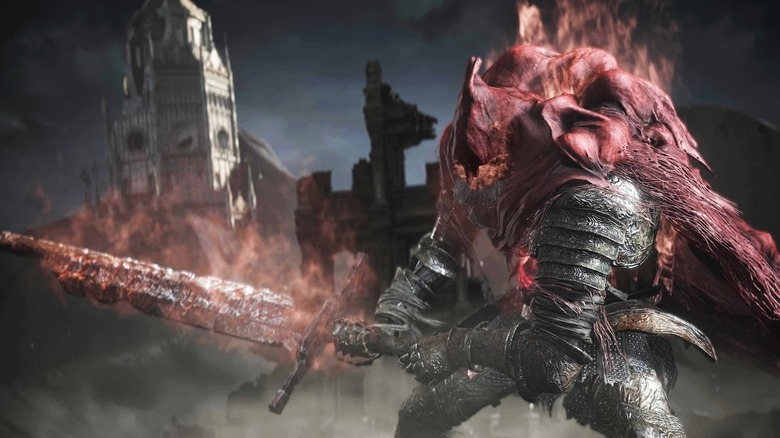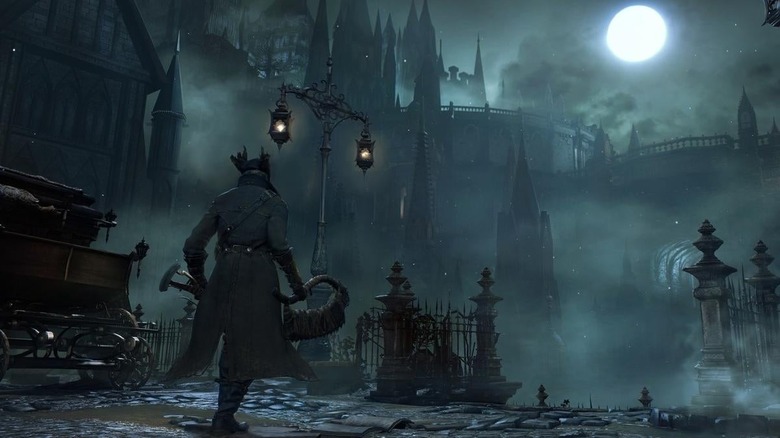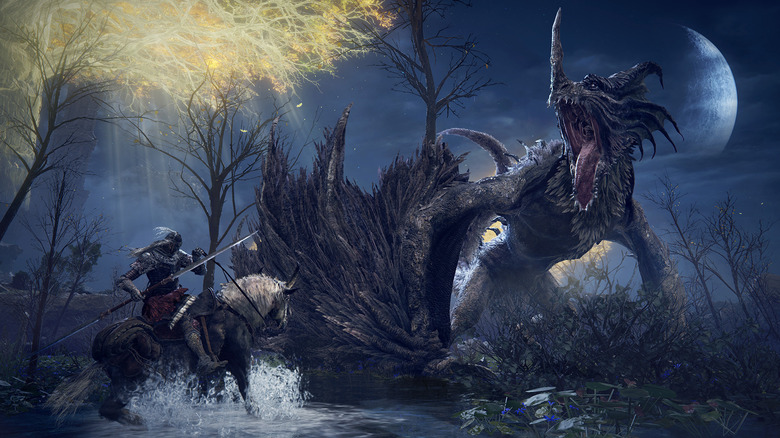Every Souls Game Ranked Worst To Best
FromSoftware has amassed a huge repertoire of revolutionary games. From the original "Dark Souls" and its metroidvania-esque layout to the punishing combat of "Sekiro," each game is different from the last, yet shares unmistakable elements with one another.
Primarily known for their difficulty, FromSoftware's "Soulslike" titles also excel in role-playing and story. Armor selections, weapons, and spells allow players to develop their own individual character. Story-wise, these titles are lore-heavy, but rather than spoonfeed explanations, FromSoftware forces the player to find the bits of history scattered throughout the world.
There are certainly some imitations, but nothing holds a candle to these experiences. That's why it is always an event when a new FromSoftware title is released. The company's newest game, "Elden Ring," is already a global phenomenon. It sold record-breaking copies in a short amount of time and gained high scores from critics, forcing players to consider where it stands among best and worst mainline souls games.
It's a tough question overall, as there are strengths and weaknesses for every release. Some titles have DLC that tip the scales further in their favor, while other games feel like a complete journey on their own. Without further ado, here are the mainline "Souls" games developed by FromSoftware — as well as the "Demon's Souls" remake from Bluepoint Games — ranked from worst to best.
8. Dark Souls 2
The only FromSoftware project not directed by Hidetaka Miyazaki, "Dark Souls 2" is considered a black sheep among the series. Don't misunderstand — it isn't a bad game, but it pales in comparison to the rest of FromSoftware's catalogue.
A big point of contention is the level design. "Souls" games are relatively consistent in their approach to world design, with most (if not all) environments tied together as a single piece. It's a wonderful feeling to backtrack to previous parts, only to stumble upon a new secret level.
Unfortunately, "Dark Souls 2" lacks this sense of awe, thanks to its use of fast travel. As Downward Thrust put it, "warping can be seen as a giant crutch." Rather than discovering the unknown, the player can just teleport to individual sections. There is no push to explore like there is in other "Dark Souls" entries. "Dark Souls 3" would later right this wrong.
Another controversial point of "Dark Souls 2" was its decision to remove respawning enemies. Once defeated a few times, enemies will cease to appear, which dissuades players from grinding and getting better (per Destructoid). Earning those last few souls for a level-up is more of an annoyance this time around. Overall, "Dark Souls 2" is a weird point in FromSoftware's history that is filled with more negatives than positives.
7. Demon's Souls
The father of them all, "Demon's Souls" was FromSoftware's first foray into its developing sub-genre. Many innovations from "Demon's Souls" have reappeared in later FromSoftware titles, including its non-linear levels, lore-heavy narrative, and sharp difficulty curve. It should be praised for establishing the tenets of "Soulslike" games.
Player messages, the risk/reward system of souls, and invasions all stem from this one game. Where it differs is its approach to level design. Five worlds make up the game, each with four levels. The player can choose where they want to start after finishing the first area. Before trudging through these worlds, they are able to choose their character's build, focusing on things like magic or melee abilities (via IGN).
But while many elements of this game were reused and improved, other parts of "Demon's Souls" show their age. For instance, a majority of bosses are gimmick bosses, requiring the use of a special item or the elimination of another NPC to win the fight. These can be good fun sometimes, but there isn't a great balance between gimmick and traditional bosses, which leads to some bland fight sequences. Successors like "Bloodborne" and "Dark Souls 3" have found a better equilibrium between these two types of bosses.
Still, "Demon's Souls" is an enjoyable romp that allows "Souls" fans to see what came first.
- Release Date: October 6, 2009
- Available On: PS3
- Genre: Role-playing game
- Game Modes: Single-player, Multiplayer
- Metacritic: 89 (PS3)
6. Demon's Souls Remake
So remember "Demon's Souls" being an ancient fossil? Well, BluePoint Games resurrected the flawed classic with its rendition on the PS5. On a technical level, BluePoint's work is excellent. The "Demon's Souls" remake gets a significant graphical facelift from the original, but the PS5's DualSense takes center stage. The controller's feedback is synced perfectly with actions in game. GameSpot's review applauded an instance of this, pointing out that slashing a wall on the right will cause rumbling on the right side of the remote. This lends superb immersion to the game.
The "Demon's Souls" remake also added other visual changes that make this the definitive way to play. Weather effects go a long way, with dynamic lighting and wind simulation making the fantastic world feel more realistic (per Digital Foundry). Character textures, destruction physics, and facial animations are also highlights. As a whole, "Demon's Souls" can almost be seen as a brand new game.
Lastly, it's important to understand that BluePoint accomplishes all of these feats without compromising the original. Bosses, weapons, layouts, and hit detection are left largely intact from the source material, and if anything was altered, it was probably for the better. For instance, one welcomed change was the omnidirectional rolling mechanics. Expanding the limited four-way rolling of the original, the remake makes movement more intuitive and strategic (via The Gamer).
- Release Date: November 11, 2020
- Available On: PS5
- Genre: Role-playing game
- Game Modes: Single-player, Multiplayer
- Metacritic: 92 (PS5)
5. Sekiro
There are no summons, magic, or broken mechanics to use as crutches here. FromSoftware's "Sekiro" is a punishing game that can only be beaten by perfecting its combat.
Rather than play patient and wait for openings, the fast-paced gameplay of "Sekiro" makes players stay on the defensive. Boss patterns must be memorized. The reason for this is that the enemy has a posture meter. This posture meter, once filled, gives an opening that can allow you to take an entire bar of health. To fill the posture meter, the player has to accurately parry a boss' extensive moveset.
The mikiri counter system takes combat to another level, though. When a red symbol pops up, the player must react with a jump, dodge, or step to avoid various enemy attacks. This creates a type of "rock paper scissors" scenario that reinforces the importance of memorization. All of these systems need to be mastered in order to succeed.
Luckily, "Sekiro" uses a number of enemies and bosses to train the player. Genichiro assesses the player's ability to parry. Comparatively, the Great Ape is wilder, requiring adaptation to quick movement. This all culminates to the final undertaking, Saint Sword Isshin. Every mechanic is utilized in the game's finale, making the player feel like they've truly perfected the combat at the forefront of "Sekiro."
4. Dark Souls
It's safe to say that "Dark Souls" created a phenomenon. "Demon's Souls" notorious difficulty is present, but "Dark Souls" reinvents that game's design elements in a huge way, garnering praise from outlets like GameSpot for having one "massive realm that's separated in distinct districts."
"Dark Souls" takes a well-balanced approach to difficulty. Like "Demon's Souls," players trod a grueling path that ends with a standard boss. Retreading the same path after every death can get redundant — until the player finds a helpful shortcut. Rather than being at a standstill, "Dark Souls" rewards the player for advancing and trying new approaches. The number of diverging paths means no two playthroughs are the same, and players can take on a number of bosses in any given order. Some areas and bosses may be more difficult than others, so the ability to backtrack and save certain sections for later is refreshing.
Even its DLC chapter is memorable. Fans have argued that "Artorias of the Abyss" is arguably the best segment of the original "Dark Souls." Shortcuts and open areas are abundant, as are harsh boss encounters. Knight Artorias and Father Manus both hit hard and give gamers little room to breathe. Best of all, the DLC functions less like a side adventure and more like a proper final act.
3. Dark Souls 3
"Polished" is the best way to describe "Dark Souls 3." FromSoftware's history is a long one, filled with improvements made between subsequent projects, and "Dark Souls 3" represents the perfection of the "Dark Souls" formula.
The diverse roster of bosses remain at the forefront. Aldrich sends incantations and arrows towards player while he wields flame attacks. Darkeater Midir is a gigantic dragon with a near-endless health bar, making the fight an endurance race. Meanwhile, Sister Friede has three whole phases to fight through. "Dark Souls 3" puts gamers through the wringer and no two battles are identical.
The same can be said of the world in which the game is set. While "Dark Souls 2" was criticized for its lack of interconnected areas, the areas of "Dark Souls 3" are widely different and can be taken as isolated environments. It does keep some connecting threads, however (via PC Gamer). Bonfires can all be fast-travelled to, but there's a cohesive path that ties the game together. This results in minimal backtracking, so the player is in a constant state of progression.
And that's why "Dark Souls 3" deserves this spot: it's a high point of the trilogy where legacy ideas aren't exhausted, but rather refined.
2. Bloodborne
"Bloodborne" is, for the most part, a traditional "Soulslike" game. What sets it apart, however, is presentation. Here, medieval fantasy is replaced by gothic horror. In turn, the world of Yharnam is haunting. As the Hunter, players are asked to take out abominations that were once human.
Yharnam is filled with people who desired to transcend beyond humanity. As a result, they've become tragic, broken monsters, creating a vast variety of enemies and leaving the player to clean up the mess. Mobs of villagers and dogs will attack in succession. Situations like these call for molotov cocktails and weapon transformations, which upgrade your weapons to become even more deadly. These transformations allow for abilities like the Kirkhammer's devastating sweeping attack, which can fend off multiple enemies at once.
During combat, health is lost after being hit, but it can he regained by going on the offensive. This becomes a double-edged sword, though, as players may easily get greedy and cause their own death by rushing in. This adds a whole layer of strategy not seen in any other "Souls" game. Lastly, critical hits are a must — backstabs and well-timed bullets offer opportunities for high damage. For these reasons, it's even more gratifying to learn an enemy's patterns and take them down.
All in all, "Bloodborne" feels incredibly unique among the "Souls" games.
- Release Date: March 24, 2015
- Available On: PS4
- Genre: Role-playing game
- Game Modes: Single-player, Multiplayer
- Metacritic: 92 (PS4)
1. Elden Ring
Recency bias may be a factor, but what "Elden Ring" has accomplished in its short lifespan is startling. Hype was at an all time high when reports first surfaced regarding a collaboration with author George R.R. Martin, and "Elden Ring" more than delivered.
The Lands Between is an intricate setting. Limgrave is a fantastic starter area, offering plenty of opportunities for open exploration. What begins as a series of little caves, mines, and other dungeons gradually becomes more complex (Game Informer). These regions are so complex that they actually encourage the player to figure out their own path to the game's finale.
"Elden Ring" also features character customization options that are nearly as limitless as its world. Katanas, spells, greatswords, and summons are here and in large supply. Some "Elden Ring" bosses can be incredibly tough, but summons like Mimic Tear and ranged incantations such as Comet Azure can help level the playing field. Or you can choose to prioritize brute strength over magic!
"Elden Ring" has many viable tools — and for good reason, because enemies are brutal. For instance, Mohg causes the health bar to drop, which in turn forces players to use up their healing flasks. Even worse is Malenia's strongest attack, which allows her to regain health every time the player is hit.
At this point, "Souls" games and open worlds go hand-in-hand. "Elden Ring" feels less like an experiment and more like a culmination.
- Release Date: Febraury 25, 2022
- Available On: PS5, PS4, Xbox Series X|S, Xbox One, PC
- Genre: Role-playing game
- Game Modes: Single-player, Multiplayer
- Metacritic: 96 (PS5), 96 (Series X|S), 95 (PC)

